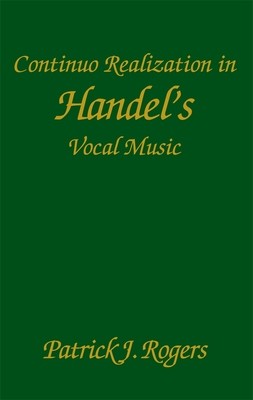
- We will send in 10–14 business days.
- Author: Patrick J Rogers
- Publisher: University of Rochester Press
- ISBN-10: 1580463614
- ISBN-13: 9781580463614
- Format: 15 x 22.6 x 1.5 cm, softcover
- Language: English
- SAVE -10% with code: EXTRA
Reviews
Description
Examines aspects of figured bass notation and continuo realization in the High Baroque, especially with respect to the operas and oratorios of G. F. Handel.
This pioneering study examines aspects of figured bass notation and continuo realization in the High Baroque, especially with respect to the operas and oratorios of G. F. Handel. Contemporary treatises, Handel's manuscripts, original performance material, and other early sources provide clarification and guidance for the modern performer. Part one is an overview of figured bass in Handel source materials: autograph manuscripts, performing scores, original keyboard parts, 18th century scribal copies, and early editions. Part two treats in depth continuo realization problems that are often overlooked and can be troublesome in modern performances. The author defines the most common bass patterns, or formula-progressions, in Handel's music, together with the precise harmony the composer intended. The author attempts to show that continuo figuring can serve different functions depending oncontext. Much of the figuring that comes down to us in secondary sources may derive from the composer, or it may reflect valid contemporary practice. Modern editions, in the main, are too selective in this regard: they only include bass figuring from primary sources, leaving the modern performer frequently without sufficient guidance in the continuo part to improvise a stylistic accompaniment. Appendices include brief examples of continuo realization by Handel. Patrick J. Rogers is an active keyboard player and former Fulbright Scholar who studied Handel under Theodor Göllner, Roland Jackson, Terence Best, and the late J. Merrill Knapp.EXTRA 10 % discount with code: EXTRA
The promotion ends in 20d.05:57:13
The discount code is valid when purchasing from 10 €. Discounts do not stack.
- Author: Patrick J Rogers
- Publisher: University of Rochester Press
- ISBN-10: 1580463614
- ISBN-13: 9781580463614
- Format: 15 x 22.6 x 1.5 cm, softcover
- Language: English English
Examines aspects of figured bass notation and continuo realization in the High Baroque, especially with respect to the operas and oratorios of G. F. Handel.
This pioneering study examines aspects of figured bass notation and continuo realization in the High Baroque, especially with respect to the operas and oratorios of G. F. Handel. Contemporary treatises, Handel's manuscripts, original performance material, and other early sources provide clarification and guidance for the modern performer. Part one is an overview of figured bass in Handel source materials: autograph manuscripts, performing scores, original keyboard parts, 18th century scribal copies, and early editions. Part two treats in depth continuo realization problems that are often overlooked and can be troublesome in modern performances. The author defines the most common bass patterns, or formula-progressions, in Handel's music, together with the precise harmony the composer intended. The author attempts to show that continuo figuring can serve different functions depending oncontext. Much of the figuring that comes down to us in secondary sources may derive from the composer, or it may reflect valid contemporary practice. Modern editions, in the main, are too selective in this regard: they only include bass figuring from primary sources, leaving the modern performer frequently without sufficient guidance in the continuo part to improvise a stylistic accompaniment. Appendices include brief examples of continuo realization by Handel. Patrick J. Rogers is an active keyboard player and former Fulbright Scholar who studied Handel under Theodor Göllner, Roland Jackson, Terence Best, and the late J. Merrill Knapp.

Reviews